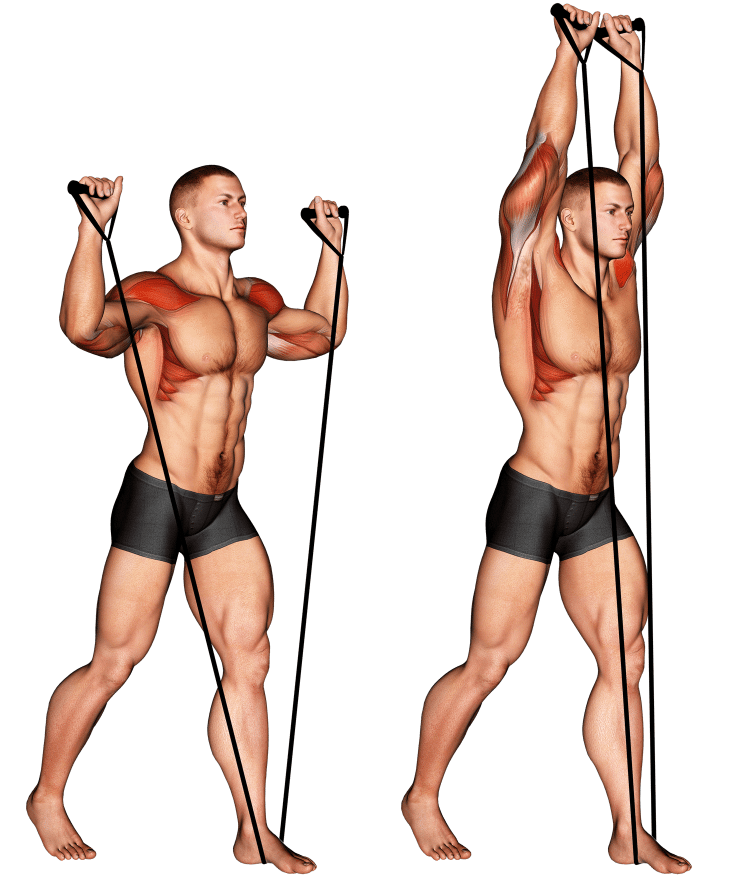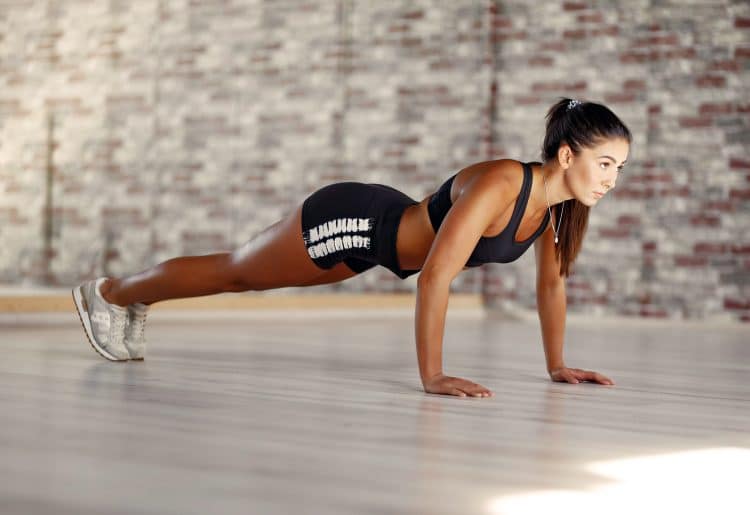While we don’t foresee gyms or weight training being fazed out ever, the fact is, with the lasting impacts of covid on our daily habits, more people are trading in their gym memberships for home or outdoor-based sweat sessions. And while some people turn their living spaces into mini fitness centers, it’s not practical for most people due to both cost and limited space.
Bodyweight training is one option but it’s either too challenging (Push-ups variations) or eventually too easy (no way to increase the load). So what’s a better, more beginner-friendly shoulder-building alternative that can be scaled for more advanced exercisers? The band shoulder press, of course!
If you lack front delt development, or want to hit all three heads at once, it’s going to be your best bet for home and outdoor workouts.
In This Exercise:
- Target muscle group: Deltoids
- Type: Strength and hypertrophy
- Mechanics: Compound
- Difficulty: Beginner
Muscles Worked During Band Shoulder Press
Don’t let the name fool you. The band shoulder press is more than just a deltoid-building exercise, recruiting the services of your triceps, and upper chest fibers too. In fact, there’s no press variation that completely isolates a single muscle and ignores the others.
Here’s a little band shoulder press anatomy 101!
Level Up Your Fitness: Join our 💪 strong community in Fitness Volt Newsletter. Get daily inspiration, expert-backed workouts, nutrition tips, the latest in strength sports, and the support you need to reach your goals. Subscribe for free!
Deltoids
Let’s do a little exercise to understand how the deltoid muscles work.
Grab your right shoulder with your left hand just below where the bone sticks up at the top of the arm. Your hand should wrap all the way around from front to back. Then move your arm in each direction as instructed below to activate each head. You should feel each muscle flex as you move your arm in three positions.
- Front delt – Lift your arm straight above your head.
- Side delt – Lift your right arm out to the right side of your body so that it’s parallel to the floor.
- Rear delt – Lift your arm back behind your body.
A band or any shoulder press variation primarily activates the deltoid anterior or front head. While bringing your elbows out wide may help stimulate the middle delts a little more, the externally rotated position of the arm still favors the front delt. Not to mention, elbows flared too wide may place the shoulders in a less safe position.
The takeaway here is that a shoulder press does not work all three heads equally. Therefore, you should still include side lateral raises to best hit the side delts, and rear flys to build up your rear head.
Triceps brachii
Another triplet muscle group like your deltoids, the triceps heads are different shapes and sizes. The long head starts near the armpit and extends through the elbow, while the medial head slaps in the middle, and the lateral fibers are positioned posterolaterally, or somewhat between the rear and side of the arm.
The triceps straighten out the arms during the band shoulder press.
Pectoralis major clavicular head
While it can be minimal, there’s still a degree of upper pec activation during vertical pressing movements. Although this is more apparent with incline angles. The clavicular fibers are just found below the collarbone and have their own expression of function which is to flex or lift the arm up in front of the body.
How To Do The Band Shoulder Press
Standing on your feet is the most convenient, and functional way to do a band shoulder press. So let’s start there, and later on you can try out some of the other variation and alternatives offered in this guide.
Here’s a step by step breakdown of the band shoulder press with video instructions.
Steps
- Grip your band by its handles then stand on the center of the band with one foot. Make sure both sides are the same length without stretching the bands. If using a loop band like the video example, stand on the band with your feet wider than your shoulders, and position your hands roughly one and half times the distance between your shoulders.
- Keeping your back straight, engage your core, then bend your knees and dip down.
- Lift the handles up to your shoulders in the pressing position with the elbows slightly in and not too flared outward, then stand up tall and strong. Lift your chest and pull the shoulders slightly back.
- If the band has handles, rotate your palms to face each other or away from you.
- Now press up and extend the arms overhead.
- Then slowly bend the elbows and lower your hands to the starting position.
- Perform the desired number of reps.
Here’s a five-minute video tutorial on the band shoulder press with safety tips and form tricks!
Tips
- Try to keep the forearms somewhat vertical, with the wrists over the elbows during the press. Although, it doesn’t have to be perfect.
- You can also use double bands, one for each foot.
- No need to lock your arms out at the top. This can actually help avoid pinching in the shoulders.
5 Benefits of The Band Shoulder Press
Whether you like the gym atmosphere, training in your living room, or prefer pumping your muscles in the fresh outdoors, band training has many advantages.
Build domes for delts
Who says you can’t build big, strong muscles with resistance bands? Well, you absolutely can with the right technique and progression methods (i.e., performing more reps than the previous workouts or using more resistance). That is, of course, if bands are all you have available. Although you could combine them with push-up variations (See variations below) for better results.
Train your delts on the cheap
Nowadays you can pick up a decent quality resistance band for less than your lunch bill (Or you can use the ones at your gym if they provide them). And the magnificent thing about bands is they have a built in resistance system. So you can vary the intensity of your workouts with the position of your feet, although there are other ways too.
As more people switch to home or outdoor based workouts, bands are the best training tool hands down, especially for those on a budget.
A convenient way to increase training frequency
Maybe you can’t get to the gym as much as you need to but you want to maintain an effective training frequency to maximize your gains. Band training is a great way to fill in those gaps, especially considering you can do it at home on your own time.
Increase shoulder stability
The glenohumeral joint of the shoulder is the most adventurous, and consequently, vulnerable joint in the human body. What we mean is it has the highest range of motion, which can be a double edged sword.
Muscles contract around the shoulder joint to form a protective seal so the shoulder can function optimally. Plus you have ligaments that support the joint. But when these stabilizers lose integrity via traumas, or other causes, you get instability, lost function, and increased injury risk.
As we climb the age ladder, shoulder health becomes more and more imperative as it has a direct impact on our quality of life. So we should be interested in performing carefully executed movements that strengthens the surrounding structures of the shoulder, and promotes longevity.
Safe and low impact
Aside from snapping back at you if not properly secured, exercising with lightweight rubber tubing is generally safer than handling iron weights, sometimes using machines, and performing bodyweight exercises too. They’re low impact, require less stability, don’t need to be set up in a rack (Easy to get started), can’t be dropped or thrown, and are a good beginning/learning variation since the resistance starts off easier and become harder.
Drawbacks of Band Shoulder Press
There aren’t many drawbacks to band shoulder presses, other than the disadvantages of the band itself. These are our minor complaints.
Unequal resistance
It’s just something you’ll have to accept. Resistance bands stretch, unlike cables, weights, machines, and your own body weight. Therefore, there will always be less resistance at the beginning of a press, and more at the end.
However, if you want a heavier start, just buy stronger bands, or shorten the band by grabbing it farther away from the ends, and perform partial repetitions to get the same strength gains. There are ways around the shortcomings of band training.
Progression requires attention to detail
Anyone can use resistance bands. But not everyone can use them effectively. In fact, it’s really easy to make minimal progress because people don’t treat them like a serious resistance tool. There are so many things that you have to think about if bands are your primary training method.
For example, how many bands do you have? What exercises will you practice? How will you use the bands? Are you tracking your sets and reps? You need to have a plan before creating a routine around bands, beginner or not.
Common Mistakes During Band Shoulder Presses
Band shoulder presses seem simple enough, right? Yes and no… Avoid these common bad habits to protect your joints, and see the gains you expect.
Using the wrong band or technique
Unless you’re not concerned with making progress, or your shoulder health, bands need to be treated like any other training implement. Many see bands as a warmup or toning aid but they can cause issues or injuries if misused.
Choose a band that allows you to perform most exercises using a full range of motion, but challenges you around the 15-20+ rep range.
Level Up Your Fitness: Join our 💪 strong community in Fitness Volt Newsletter. Get daily inspiration, expert-backed workouts, nutrition tips, the latest in strength sports, and the support you need to reach your goals. Subscribe for free!
Doing the same sets and reps every time
The perfect recipe for stagnation, the inability to track your progress as easily compared to weights makes bands a potentially complacent training option.
Make note of your sets and reps, foot placement, band length (Amount of resistance), and band strength between workouts so that you’re getting ahead, and not spinning your wheels.
Pushing through shoulder pain
The shoulders are a common pain area for many, and especially active individuals. Sometimes we add fuel to the fire by ignoring or pushing through pain because we need to get our training in. It’s not smart.
Sometimes you need to change your technique (i.e., bring the elbows closer together), or adjust the resistance. And this brings us to the next common mistake which you should avoid altogether, unless you decide that you’re experienced enough with shoulder training, know your body very well, or are willing to take the risk.
Flaring the elbows super wide
While some people will flare the elbows and press with no issues, it’s not a risk we want beginners or intermediates to take. When the elbows are out to the side or even behind the neck, it limits your shoulder’s optimal range of movement. This can be dangerous for the glenohumeral joint. Instead, bring the elbows slightly forward in front of the body and this will free up the shoulders to move the way they should.
Fast negatives
With free weights and machines, the resistance is not stretched and released. You don’t want to let the band release or shorten too fast as it can be hard on the joints (Not low impact), and eliminate half the potential benefits of slow and controlled negatives.
Variations and Alternatives of The Band Shoulder Press
If you run out of shoulder exercises then you’re not looking hard enough. There are endless ways to build beefier or toned delts. Thankfully, for you guys, we curated the following list of band shoulder press exercises, and you can always modify them to suit your needs or comfort.
Related: Military press vs. overhead press vs. shoulder press vs. push press – differenced explained
Reverse close grip band shoulder press
What’s the advantage of using a reverse close grip? You’ll notice right away that the elbows are closer together which is safer for the shoulders. Additionally, something about using a reverse grip (Palms facing you) feels better in the front delts. For this variation to work, the hands should be no wider than shoulder distance apart.
Try it out, you won’t be disappointed.
Seated band shoulder press
Rather than use your feet to anchor the bands down, you can sit on a bench, chair, or whatever you have, wrap the band/s underneath it, then perform presses that way. We recommend using a wider seat, which will increase the resistance and also keep the bands out of your way.
Standing leaning band shoulder presses
If you have something to anchor your band to like a tree branch, swing pole, pillars, etc, you can change your body position to mimic a shoulder press.
Wrap the band around your object, face away from it, lean forward at the hips with a split stance, and press forward so that your arms are vertical to the ground. If you do it correctly, you should look like Superman flying as you press out.
Dumbbell shoulder press
Dumbbell shoulder presses are the ultimate functional strength and mass building shoulder combo that should be worked into your overhead pressing rotation. Not barbells, cables, or machines can challenge your body’s abilities like a heavy dumbbell lift.
Fighting to maintain control of two implements on separate sides of the body, we adore all things dumbbell related.
Advantages: More functional, good for athletic training, challenging the core, stabilization, and fixing left to right strength imbalances.
Kettlebell shoulder press
The unique shape and design of kettlebells means you’ll need to work a little harder to stabilize these sometimes awkward, medieval looking ball and handles. But that’s all part of the fun (It really helps mentally to change things up in your training). The kettlebell will simultaneously train your core and fortify the health and integrity of your glenohumeral ball and socket shoulder joint.
Here are some highly recommendeds kettlebell variations.
Advantages: Shoulder stability, balance, coordination
Machine shoulder press
Cable press and machine shoulder presses are the best options for focusing on pure strength, and massive gains without having to think too much. Simply adjust the machine to your liking, select the weight and have at it.
You still need to be careful though, as some machines can feel awkward for the shoulders. Opt for one that allows you to keep your elbows somewhat in front of your body, not flared all the way out. This will protect your shoulders from pain and injuries.
Advantages: Purely strength based, no stabilization required.
Barbell shoulder press
Most people won’t bother with the barbell press because it’s akin to what the squat is on leg day. But it is the functional version of using machines because it allows you to lift the most weight while activating your kinetic chain and strengthening every component of your body.
Advantages: Overall strength, athletic power and performance
15 Best overhead barbell press variations for big, powerful shoulders
Push-ups
The king of bodyweight calisthenics, everything from basic to handstand push-ups work your shoulders. Although, the higher you elevate your feet (e.g., handstand push-up) the more resistance and deltoid activation.
Advantages: Bodyweight only, learn functional and natural movement patterns.
Find every type of push-up variation here.
FAQs
How do I choose the right band for shoulder presses?
We always recommend having a few resistance bands of varying strength. Although, it really depends on your goals.
For example, a beginner may not need much resistance when they start a workout regime. So a light or light-medium band could work just fine.
If you’re naturally stronger, it’s better to get a heavy band, and then you can always go heavier from there.
How many sets and reps should I do?
This depends on your experience and workout program. However, as a general suggestion, we recommend a minimum of 2-3 sets x 10-20 challenging reps per training session.
Is it possible to maximize my shoulder development with band shoulder presses?
While shoulder press variations are key to making strength gains, the deltoids are a three headed muscle that will most certainly benefit most from a variety of exercises, angles, and training techniques.
So do your presses but also incorporate raises, flys, and other movements to maximize your full potential.
Wrapping Up
If you need the perfect minimalist, gym-free, safe beginner-friendly shoulder exercise to create more dimension to your deltoids, the band shoulder press ticks off all the right boxes. While it does primarily challenge the anterior head of the shoulder group, you’ll also see benefits for the outer and rear deltoids too.
Still exercise caution when handling bands as they can snapatcha, so make sure they’re properly anchored down before commencing each set. Lastly, combine your band training with other methods and variations to see the fullest deltoid development.
Interested in measuring your progress? Check out our strength standards for Push Ups, Arnold Press, Push Press, and more.











